Amplicon sequencing is the sequencing of PCR products or captured fragments of a specific length, analyzing variations in the sequence. The 16S rRNA gene has been a mainstay of sequence-based bacterial analysis for decades. 16S/18S/ITS amplicon sequencing involves extracting DNA from environmental samples, selecting suitable universal primers to amplify the target region of 16S/18S/ITS, and detecting sequence variation and abundance in the target region to study differences in environmental microbial diversity and community composition.
Technical advantages:
1. High throughput, suitable for studying specific genomic regions with a large number of samples;
2. Short cycle, which can shorten the research cycle, and accelerate clinical application and article publication;
3. High degree of information, searching for genetic variation sites in genome regions of interest, allowing for in-depth research on specific regions.
Microbial Amplicon Sequencing Analysis of Microbial Population
The increased risk of lung cancer is associated with exposure to cigarette smoke carcinogen and changes in intestinal microbiota. However, the impact of exposure to NNK and BaP (two important components of cigarette smoke carcinogen) on the intestinal microbiota of lung cancer is limited. A recent study describes the effects of exposure to a mixture of NNK and BaP on lung cancer, fecal metabolite composition, and gut microbiota in mice. Apply NNK and BaP to A/J mice, and use 16S rRNA gene sequencing and metabolomics to characterize changes in gut microbiota and fecal metabolism profiles, respectively. The results of light microscopy and histopathology evaluation showed that the exposure of the mixture of NNK and BaP triggered the occurrence of lung cancer. 16S rRNA sequencing of the gut microbiota showed that exposure to NNK and BaP can alter the composition of fecal bacteria. The increased levels of actinomycetes, bifidobacteria and Enterobacteriaceae, as well as the decreased levels of physiologic bacteria, visceral odor bacteria and Acetatifactor bacteria, are associated with NNK and BaP induced lung cancer. This study can provide some guidance for using gut microbiota as biomarkers to evaluate the progression of lung cancer and provide intervention targets for future control of the disease.
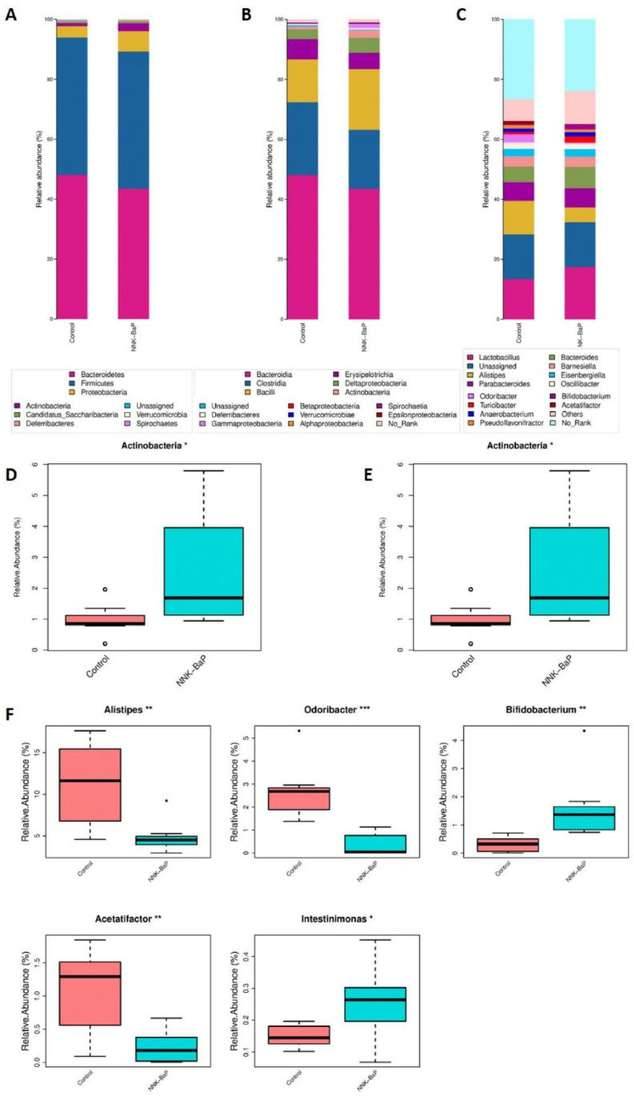 Evaluate the gut microbiota of each group through 16S rRNA gene sequencing. NNK plus BaP reduces microbial species richness and microbial community imbalance at different taxonomic
Evaluate the gut microbiota of each group through 16S rRNA gene sequencing. NNK plus BaP reduces microbial species richness and microbial community imbalance at different taxonomic
Amplicon sequencing assists in microbial resistance research
Neonicotinoid insecticides are applied worldwide for the control of agricultural insect pests. The evolution of neonicotinoid resistance has led to the failure of pest control in the field. Research has shown that insect symbiotic bacteria can directly metabolize toxic substances or indirectly mediate the expression of host detoxification enzymes or related genes, thereby affecting the detoxification metabolic function of insects. The 16S Amplicon sequence showed that the abundance of sphingosine spp. in the gut of imidacloprid resistant cotton aphid was significantly higher than that of sensitive cotton aphid. Further research found that the removal of sphingosine from the intestinal tract of the imidacloprid resistant strain of Aphis gossypii could increase the sensitivity of Aphis gossypii to imidacloprid, and the addition of sphingosine to the imidacloprid sensitive strain of Aphis gossypii significantly reduced its sensitivity to imidacloprid.
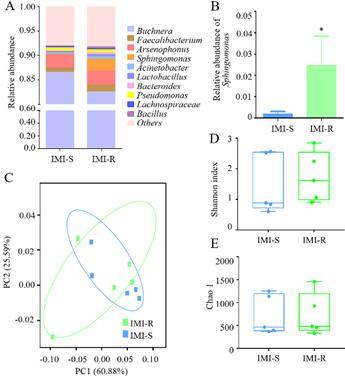 Differences in gut communities between imidacloprid resistant and sensitive strains of cotton aphids
Differences in gut communities between imidacloprid resistant and sensitive strains of cotton aphids
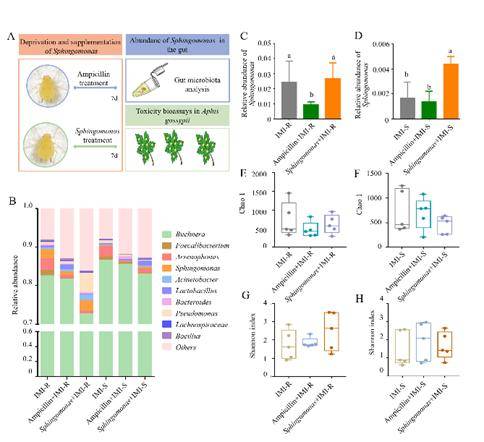 Changes of intestinal community of Aphis gossypii after removal or supplementation of sphingosine
Changes of intestinal community of Aphis gossypii after removal or supplementation of sphingosine
16S sequencing technology analysis of intestinal microbiota to assist in precise drug use
Irritable Bowel Syndrome (IBS) is commonly believed to be an intestinal disease caused by disorders of the brain gut axis, and its etiology may be multifactorial, which mainly including changes in the gut microbiota. Researchers collected 346 IBS patients and 170 healthy control (HCs) populations, all of whom completed a dietary inventory survey to reflect the most frequently consumed diet. Then the researchers collected fecal samples from 171 IBS patients and 98 HC patients for 16S rRNA gene sequencing and microbial composition analysis. The 16S sequencing results showed that the abundance of Rieknellaceae and Paraacteroides in the IBS group was higher than that in the HC group. When adjusting diet and race, only Rikenellaceae showed higher abundance values in the IBS group. This study has shown that IBS patients may consume more restricted diets than HCs in order to reduce the severity of gastrointestinal symptoms, which can affect the composition of fecal microbiota. The gut microbiota causes physiological changes in brain gut interactions, thereby affecting IBS symptoms. Although the microbiota of patients with irritable bowel syndrome is undoubtedly variable, changes in gut microbiota caused by diet can explain the differences between the irritable bowel syndrome and HC groups.
 Microbial community analysis of IBS subtype patients
Microbial community analysis of IBS subtype patients
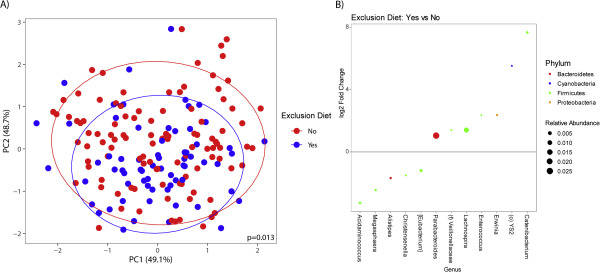 Exclusion diet and non exclusion diet for IBS patients β Diversity analysis
Exclusion diet and non exclusion diet for IBS patients β Diversity analysis
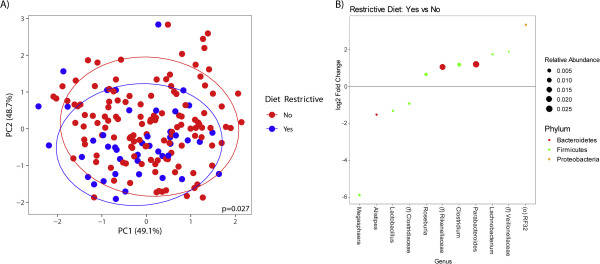 The relationship between restricted and non restricted diet IBS patients β Diversity analysis
The relationship between restricted and non restricted diet IBS patients β Diversity analysis
Amplicon sequencing technology has shown great advantages in exploring the relationship between microorganisms and human diseases, as well as the relationship between microorganisms and the environment. In the future, it will be a powerful tool to explore the mysteries of microorganisms.
References:
- Lv, Nannan et al. "The gut symbiont Sphingomonas mediates imidacloprid resistance in the important agricultural insect pest Aphis gossypii Glover." BMC biology vol. 21,1 86. 17 Apr. 2023.
- Lenhart, Adrienne et al. "Effect of Exclusion Diets on Symptom Severity and the Gut Microbiota in Patients With Irritable Bowel Syndrome." Clinical gastroenterology and hepatology.
For research purposes only, not intended for clinical diagnosis, treatment, or individual health assessments.


 Sample Submission Guidelines
Sample Submission Guidelines
